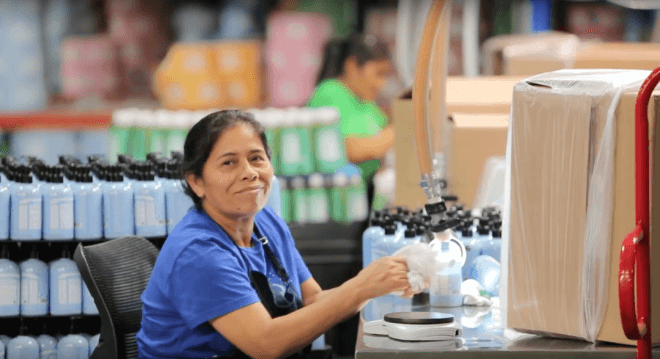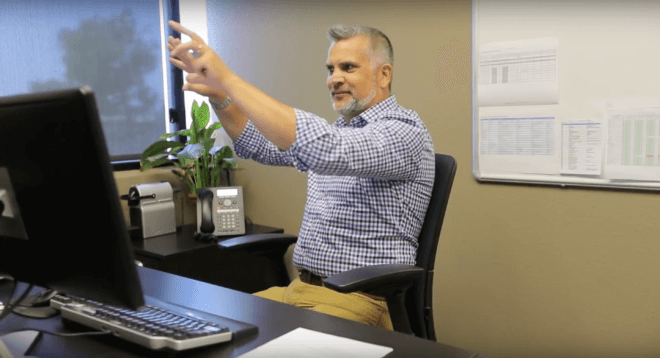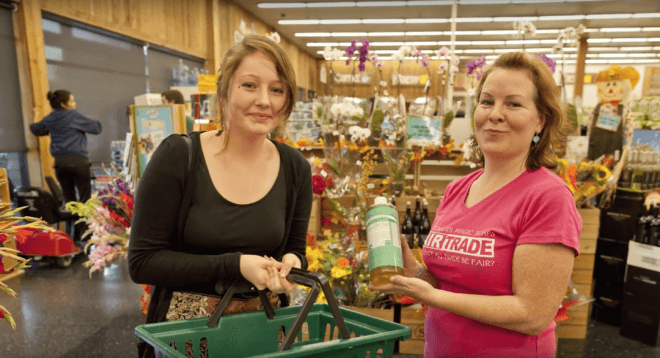In November, I had the honor of speaking to a room full of Project Green Challenge finalists. This is an inspiring group of high school and college students from all over the US, who have all completed a grueling month of “green” challenges and have been selected as finalists for their tremendous efforts and creativity in completing the challenges. Here is the speech I gave to the finalists, with a transcript below:
It is wonderful to be back here. I love this space, it’s such a gorgeous library. Libraries are one of my happy places, so I’m always very glad to be here.
So you students—who just completed the intense month of October and all of your daily challenges—I don’t know how you fit that into your life—and your stories must be incredible, something—probably your sleep—got lost along the way. But you’ve done this crash course in “green”-ness and what “green” is, and all of these different manifestations that this word has. And so going forward I want to try to sum it up: what does green look like?
And so I’m going to propose to you that green is not what you are doing, but rather how you are doing it.
In a former life I was an English teacher, before I had kids—love to talk about Great Expectations if anybody has read it. But I enjoy grammar so I’m going to propose to you that green is not an adjective to describe a noun but that it is an adverb to describe an action—that you live greenly, you work greenly, you decide things greenly, you think greenly—so green looks like every realm of human endeavor.
There are not green fields of work and non-green fields of work. Today alone you have heard from people who are champions of environmental consciousness and they come from many different fields of work. You heard from Debbie Raphael who has taken the challenge in the realm of government. You’ve heard from Stacey Malkan and taking it frontline into activism. You’ve heard from filmmakers, from writers—and you’ve heard from manufacturers. You’ve heard from scientists and collaborators—and this alone shows you that being green is not a field, but it is life itself.

What this adds up to is that green is not a hobby. It’s not something you do part time—that you will do green stuff when your regular work is done.
It also means that there will never be a time in your life that you need to decide between continuing with this green stuff or going on with something more practical or realistic.
Being green is not an either-or.
And to show this case in point I’d like to present what Dr. Bronner’s looks like from a green perspective. Dr. Bronner’s is known for its revolutionary labor practices, it’s known for the self-created vertically integrated supply chain that is fair trade and sustainable—and it’s known for making really good soap. But I want to explain to you how Dr. Bronner’s as a business—it’s easy to stereotype that business is contrary to any green field—but how business can be done to further green effort.
So you may have heard that a year ago, Dr. Bronner’s restructured legally as a Benefit Corporation instead of an S Corporation. And as a Benefit Corporation it protects the social and ethical work that we do for future generations. Who knows what will happen after my current generation of running it, we can’t guarantee that our kiddos that are coming up through the schools will join the company, who knows where they’ll be—but it protects Dr. Bronner’s to be able to continue to do what it does for years to come. (We are also part of the B Corp certification.)
In getting this restructuring we analyzed our mission as a company and we had the realization that first and foremost we are a manufacturing company: we make a product.

However the purpose that we make this for is to do it well enough so that we can do good. To do it well so that we can do good. To work hard so that we can benefit the world in which we live.
Because of this the benefit that Dr. Bronner’s provides around the world—primarily—is not in the extra that we do—it’s not in the extra charitable giving that we do, although we do a good bit of it, over 8% of our revenue goes to charitable causes. But the main benefit that Dr. Bronner’s has as a corporation is in the very DNA of who we are as a manufacturing company. In our cost of goods sold, in our labor practices.
You cannot separate what we do—for sustainable efforts, ethical efforts—you cannot separate that for what we make as a product.
If the economy changed to the point—I don’t know what would change the economy to the point where we didn’t need soap—but let’s say things got really tight and we needed to tighten our belts—we could not do it in such a way that we tightened our belts so much that it deprived the 10,000 farmers who supply our coconut and olive oil and palm kernel oil—to deprive them of a job because we need them they make soap. It’s a different cause and effect.
At Dr. Bronner’s we don’t say to our consumers: if you bought a bottle of our soap then we’re going to help a coconut farmer in Ecuador. We don’t say: if you buy a bottle of soap we will then donate to sustainability efforts in Sri Lanka. We don’t say: if you buy a bottle of soap we’re going to contribute to hemp farming in the US.
By the time that bottle of soap has reached the shelf where you can buy it, all of that has already happened—because it’s in the soap. Now, your purchasing the soap means that we can continue to do it.
And it’s not to say that Dr. Bronner’s doesn’t give on top of this. But, I want to emphasize that because of the business, the soap manufacturing we are able to do, we do the green work there and not as extra.
So what does green look like? There are some pretty obvious things that green looks like: green looks like a beautiful field of industrial hemp (in Kentucky); green also looks like a coconut farmer in Kenya who is guaranteed work, guaranteed a market, guaranteed a fair price for his labor, when he uses sustainable and organic techniques to grow his coconuts.
Green also looks like this worker in Ghana processing palm kernels into palm kernel oil. We know that that looks green.
But I’m going to propose to you this [picture of Benicia on screen] looks just as green as those farmers. This is Benicia—she’s worked for Dr. Bronner’s for 20 years—she and I have had our children together—and she works on our production line. Because of her we are just as green of a company as with the farmers.

Green also looks like this. I don’t expect you to understand this—I don’t—but this is coding. And without this coding Dr. Bronner’s could not exist. So, the particle physicist Mike Wodarczyk, who is our on-staff programmer, is just as much a green champion as those out growing the field of hemp.
Green looks like this: it looks like a database filled with numbers made by somebody who gets excited about data—and I’m speaking of my husband right here—Michael Milam is our Chief Operating Officer—and this is the language he speaks.
He is not an activist on the front lines—he’s not anybody that you would look at it see “green” necessarily—he looks like a business person.
But business is green.
And so I propose to you that as you’re thinking where to go now, don’t limit yourself to the overtly green fields—don’t leave here and think you’ve gotta make a decision on whether the engineering degree you were pursuing needs to be abandoned because now you’ve had this great realization of the importance of green efforts. Combine them, take it with you as you go forward.
Whether you end up making soap, building something, computer program coding—all of that stuff that is not my language—all of that could be done for green efforts. The people that are making Dr. Bronner’s move there in the engine room, still see the horizon where we’re headed.
So what does green look like? It looks like work.
It looks like all the normal business practices you see in a company: the accounting, the human resources, the sales, the marketing, the shipping, the freight—but done for a better purpose. It is work done greenly. So take green with you wherever you go—whether it’s architecture or dance or design—take it with you and let this be a jumping-off place and not the end.